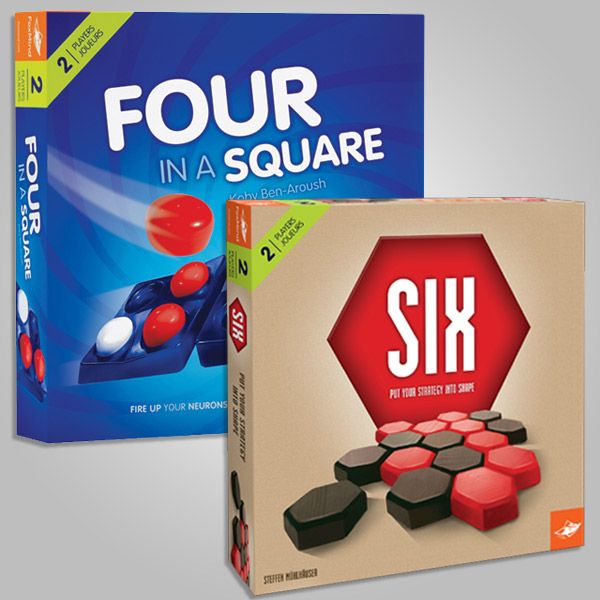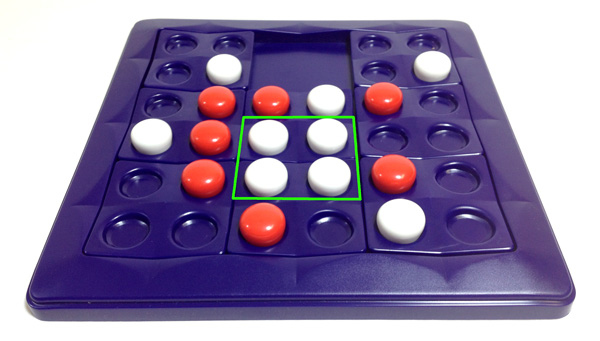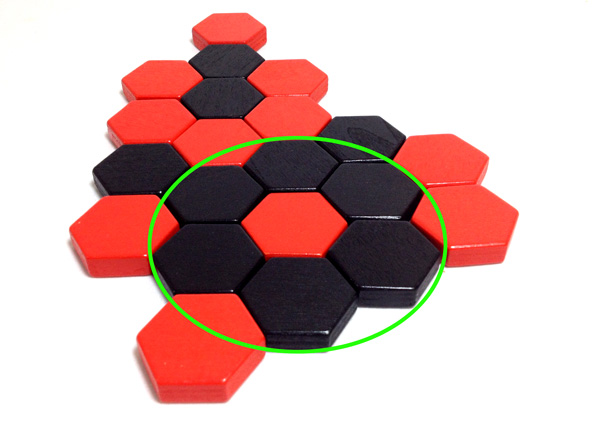Two, Four, Six, Eight, These Abstract Games are Great: A Review of Four in a Square and Six

Two abstract strategy games by FoxMind, Four in a Square and Six, allow players to best their opponent in a head-on match of strategy. Four in a Square ingeniously adds depth to pattern-forming games by implementing sliding tiles. Six is played with red and black hexagons; each player places only one tile each turn and tries to create one of three winning shapes.
Gameplay
Four in a Square is a 2-player game that is played with 8 sliding tiles, in a 3x3 arrangement. This leaves one empty slot where other tiles can slide into it. Each tile has 4 slots for red and black markers. Each turn, players place one marker and slide one tile in attempt to form four in as square (as the name of the game suggests).

Six consists of only red hexagons and black hexagons. The objective is simple: be the first player to form a line, triangle, or full ring of exactly 6 tiles. Each turn, players place one tile, attempting to complete a shape or block their opponent. If there is no winner after all 40 tiles have been played, players start moving tiles from the edge to new locations. In addition to the standard 2-player version, the game can also be played with 4 people — each player works with a partner with whom he or she cannot communicate in any way.

Review
As their name suggests, FoxMind is all about thought-provoking games, and both of these games deliver. Both games have high-quality, undistracting components. Neither game implements a theme — just raw, abstract strategy at its finest. Nothing is left to luck in Four in a Square or Six — it is wits versus wits in a quick and simple format. This is great for anyone who gets frustrated when those blasted dice are not cooperating.
Four in a Square can be quite tricky — between placing a token and sliding a tile, it is surprising how quickly and sometimes unexpectedly a square can be formed. With only two caddy-corner tokens, I saw no threat until my opponent placed another token and slid the last corner of the square into place for the win. The constantly shifting board adds a layer of fun and intrigue that is not present in similar games.
Six also demands the close attention of both players, as there is nearly a perfect balance between setting up your own combinations and blocking your opponent. The difficulty level is similar to Checkers. The red and black hexagons are made of wood and have a quality feel to them. This is a game that you would never have to replace — it should last until your grandkids are playing it. With tiles that can be played on any flat surface and a nice cloth bag to contain them, Six is well-suited for portability.
Both of these games target a specific audience. They are perfect for new casual gamers and anyone who enjoys abstract games like Checkers and Connect Four. They are instantly learnable and quick to play, making them ideal for impromptu gaming sessions such as lunch hours or family play. However, if you rely on luck or powerful cards to win games, then these two might not be for you.
Pros: High quality components, perfect intro into abstract games, very easy to learn, great filler games
Cons: Not ideal for opponents of different abilities, can become a bit repetitive after multiple sessions







